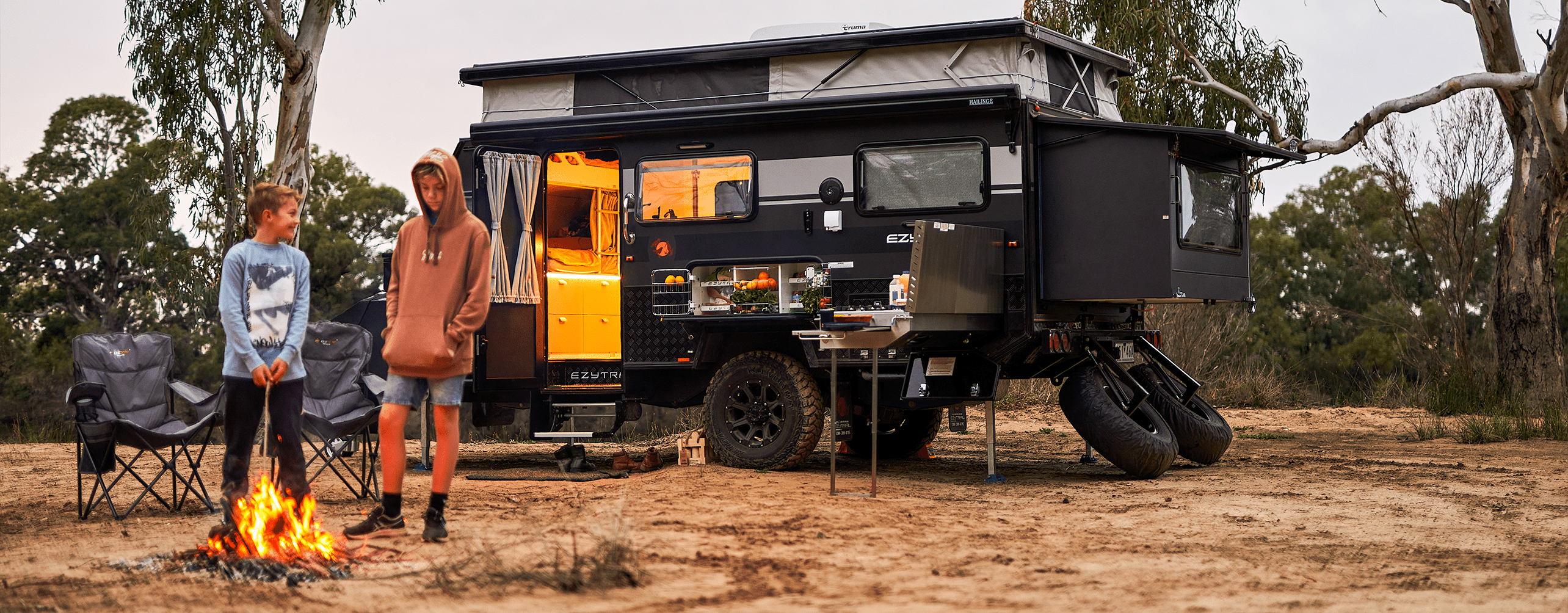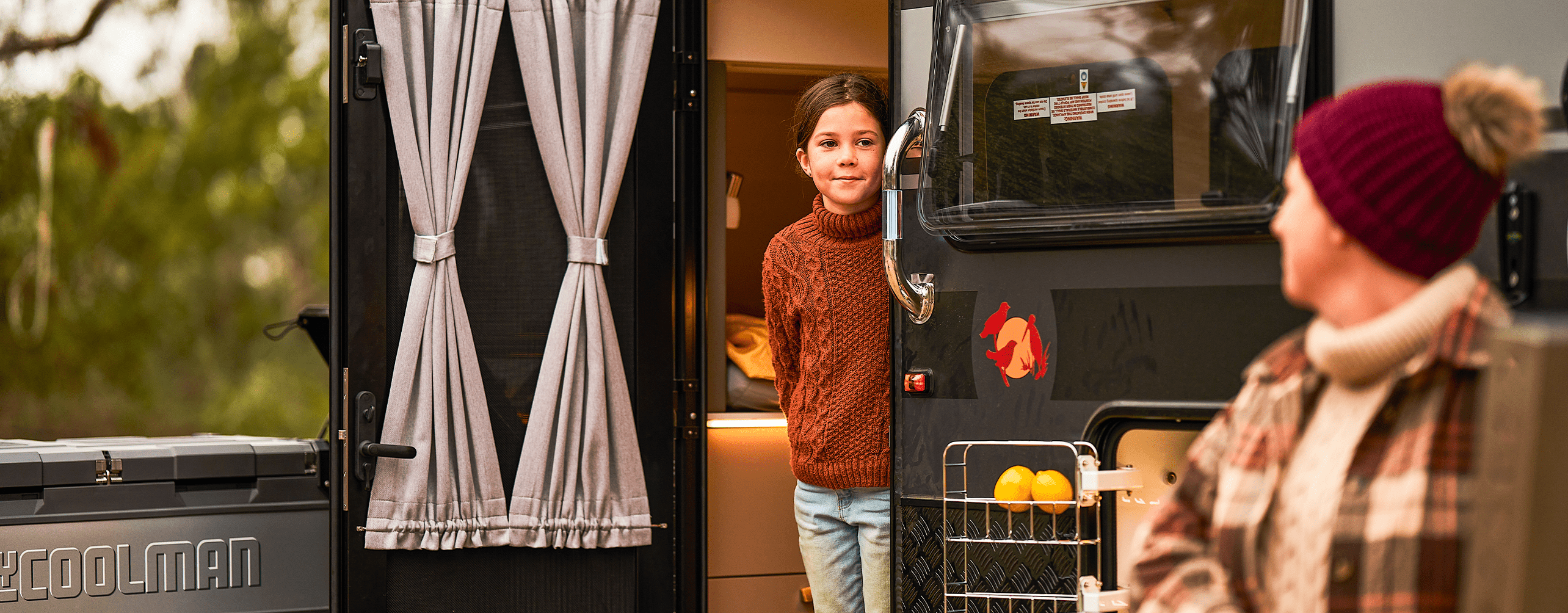With the scorch of summer settled, autumn is prime camping season. But when the sun goes down, so does the temperature. The upside is that you’ll have a nice campfire to light up your getaway.
For seasoned campers, building a campfire is second nature. For those of us who need some tips for this timeless campsite ritual, read on and learn how it’s done—from preparing to extinguishing.
Let’s get crackling!
Why make a campfire?
Firstly, and obviously, it’s nice and warm! While you’ll be cosy sleeping inside your hybrid caravan, camper trailer, or caravan, you’ll probably need some extra warmth when you’re outside under the stars.
The fire will also be your source of light. Yes, you could just turn on your outdoor LED caravan lighting and increase visibility, but we all know there’s more to a glowing fire, especially one that you built yourself, which brings us to the next point.
Our obsession with fire is as old as humanity. It was our heater, protector, and stove, all at the rub of two sticks. It was also where we gathered to tell stories and build a community. These days, while we have electric blankets to keep us warm and Netflix to keep us entertained, nothing can separate us from the shared experience of an open fire.
Now, onto the serious stuff!
Where should you start a campfire?
Firstly, check for any fire bans or restrictions in your camping area through official state or territory websites. Many places have designated fire pits to minimise bushfire risks. But like many in the Ezytrail community, if you prefer to go offroad with your caravan or camper, we highly recommend following local guidelines to avoid any mishaps or accidents.
Finding a Safe Spot
Keeping yourself, your family and the environment safe should always be your number one priority. Here’s what we recommend:
- Use established pits for convenience and safety.
- Choose a clear, flat area on non-flammable ground, ensuring no overhead hazards.
- Pick a sheltered spot to control embers.
- Maintain a safe distance from caravans, tents, and vehicles.
Campfire Essentials
Before lighting a fire, it’s important to understand the basics.
- Tinder: Dry leaves and old paper, which catch fire easily.
- Kindling: Small sticks and twigs, which help the fire grow.
- Wood: Larger logs, which sustain the fire once it’s well established.
- Firelighters: Small cubes that help start the fire more easily.
How to Start and Maintain a Fire:
- Begin with a bed of tinder.
- Layer kindling on top.
- Place two or three firelighters among the tinder or beneath the kindling for easier ignition.
- Light the tinder and firelighters and wait for the kindling to ignite.
- Add larger logs, ensuring airflow underneath.
- Once the fire is well established, add larger logs periodically to keep the fire going. Important: Always use dry logs, kindling, and tinder. If any of it is wet, the fire will struggle to ignite and stay lit.
Fire Safety Essentials
Whether solo or with family, prioritise fire safety by packing necessary items and practising safe fire management:
- Bring along extra water, a shovel, matches and fire starters, a first aid pack with burn treatment, a fire blanket and extinguisher.
- Never leave the fire unattended.
- Make sure everyone is familiar with fire safety.
Leaving Your Campfire
Putting out and clearing up your fire is as essential as starting it. Here’s what to do:
- Extinguish: Thoroughly douse the fire with water, stir the ashes, and apply more water.
- Clean up: Pack away anything you used to light the fire.
- Restore: Leave the site as you found it, without any trace of your fire.
Fun and Safe Activities Around the Campfire
The magic of the campfire goes well beyond warmth and light. Here is some fire-related fun that kids and adults alike will love.
-
Marshmallow Stick Hunt: Before the sun sets, embark on a quest to gather a bunch of perfect sticks to pierce and roast those marshmallows. What makes the perfect stick, you ask? Look for ones that are about 50–100 cm long, which should allow plenty of distance between your hand and the flame. The stick should also be thick enough to support the marshmallow, roughly the thickness of a pencil. Make sure you strip the bark away from the stick to ensure it’s clean, and sharpen the end if necessary so that you can pierce the marshmallow with ease. Once you’ve got your sticks of choice, you’re ready to roast!
-
Fire Starter Hunt: Search for pine cones, dried bark, and little twigs around your campsite. This activity helps everyone get involved in the fire-starting process, especially those who are too young to start and maintain the fire.
-
Magic Flame Powder: Before you head out on your trip, grab some magic flame powder from a camping store or online. Sprinkling a little on your campfire can turn the flames into a mesmerising display of colours, making it even more magical.
These activities are not only great fun; they’re also a way to connect yourselves to the campfire experience. While you’re enjoying these activities, just remember to keep a close eye on the fire and the people around it—safety is the number one priority!
A good campfire will be the centrepiece of your campsite, providing warmth, light and a great place to gather around with your family and friends. With these helpful tips, you’ll be ready to create some memories around your expertly crafted campfire.



